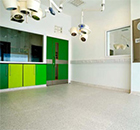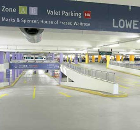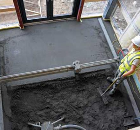Sustainability is an increasingly important factor in the design of all kinds of buildings, including multi-storey car parks. The size of these structures, often large, have a significant impact on the environment, so it is crucial to consider sustainability from the outset. As urban areas continue to grow, the demand for efficient and convenient parking facilities also increases. The development of multi-storey car parks provides a high number of parking spaces in a relatively small space so when designing car parking structures, their environmental impact needs to be considered and minimised to ensure their long-term viability.
What can manufacturers do to assist sustainability initiatives? In this article, Flowcrete will look at the use of sustainable materials and investing in energy efficient processes as some of the key considerations when designing multi-storey car parks with sustainability in mind.
Sustainable materials
The materials used in the construction of a car park can have a significant impact on its sustainability. When specifying carparks, some options to consider include:
• Recycled materials: Using recycled materials in the construction of a car park can help to reduce waste and lower the environmental impact of the project.
• Low-VOC materials: Volatile organic compounds (VOCs) are chemicals that can be released into the air from certain building materials. Using low-VOC or zero VOC materials can help to reduce indoor air pollution and improve the overall indoor air quality of the car park.
• Durable materials: Using durable materials that will last for many years can help to reduce the need for repairs and maintenance, which can be both energy-intensive and wasteful.
Energy Efficiency
Multi-story car parks are often energy intensive, with lighting, ventilation, and security systems all requiring significant amounts of energy to operate. By using energy-efficient design techniques, car park designers can significantly reduce the energy consumption of these facilities and contribute to the reduction of greenhouse gas emissions. One of the key challenges of designing multi-storey car parks is finding a balance between efficiency and sustainability. Car parks need to be able to accommodate a large number of vehicles in a small space, which can sometimes be at odds with sustainable design principles.
What can designers consider when it comes to car park construction?
• Using renewable energy sources
• Creating car parks designed to accommodate electric and hybrid cars
• Incorporating energy-efficient lighting systems, insulation, and heating, ventilation systems
• Looking for every option to save energy throughout the construction process.
In addition to material selection and energy efficiency, architects, specifiers and designers should also consider the long-term maintenance and operation of multi-storey car parks. This includes designing the car park for ease of maintenance and repair.
Considering sustainability in multi-storey car parks is an essential component of any modern city’s infrastructure. By carefully considering these factors, architects, specifiers, and car park designers can help to create a more sustainable future for cities and communities. Consider Flowcrete’s Deckshield car park waterproofing systems. Environmental and health considerations are controlled during manufacture and application of its systems.
Thinking green with car park structures
| T | 01942 251 400 |
|---|---|
| E | hello@tremcocpg.com |
| W | Visit Flowcrete UK's website |
| The Flooring Technology Centre, Booth Lane, Sandbach, Cheshire, CW11 3QF |
Products by this Company






